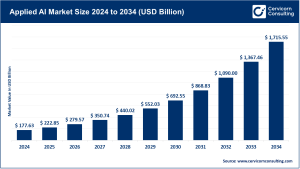Market Overview
The global remote monitoring and control market was valued at around USD 24.81 billion in 2024 and is anticipated to reach USD 33.95 billion by 2034, growing at a CAGR of 5.8% over the forecast period. The market’s expansion is fueled by rising demand for precise, scalable monitoring solutions across healthcare, industrial automation, smart infrastructure, and other sectors. Cutting-edge IoT-enabled sensors, AI-powered analytics, and cloud platforms are driving real-time, intelligent monitoring, while environmentally sustainable and energy-efficient devices are becoming increasingly important for operations with a focus on reducing environmental impact.
Get a Free Sample: Cervicorn Consulting
Key Market Trends
-
Sustainable Remote Eco-Monitoring Solutions
Organizations are integrating biodegradable materials, energy-efficient sensors, and modular components to minimize environmental impact. For instance, Honeywell’s 2025 sustainability roadmap emphasizes energy-positive monitoring systems with recyclable electronics, supporting circular economy practices. -
Digital Remote Control Integration
The combination of portable control devices, cloud-based analytics, and AI-driven insights is enhancing operational visibility and decision-making. Siemens’ recent launch of an AI industrial monitoring platform demonstrates this trend by offering predictive diagnostics and seamless enterprise management. -
Cloud-Based Deployment Dominance
Cloud solutions now represent over 41% of RM&C deployments, enabling multi-site integration, real-time analytics, and scalable monitoring. Industries favor cloud platforms for flexibility, AI integration, and remote accessibility, particularly in critical healthcare and industrial environments. -
Edge AI and Real-Time Analytics
The integration of edge computing with AI allows for immediate data processing near the source, reducing latency and supporting predictive maintenance. This trend is improving operational efficiency in utilities, manufacturing, and energy sectors, minimizing downtime. -
IoT-Driven Smart Infrastructure
RM&C systems are increasingly embedded in smart factories, smart cities, and healthcare ecosystems, enabling automation, predictive operations, and optimized resource management. Applications such as remote patient monitoring and industrial process control highlight the growing adoption of connected, intelligent infrastructures.
Market Drivers
-
Increasing Operational Complexity: Modern industries and healthcare systems require precise, real-time monitoring of multiple parameters, which RM&C solutions provide, reducing disruptions and enhancing efficiency.
-
Technological Advancements: AI, IoT, cloud computing, and edge analytics innovations are making RM&C systems smarter, scalable, and predictive.
-
Government Initiatives and Regulations: Policies promoting smart infrastructure, energy efficiency, and healthcare digitization accelerate adoption. North America leads the market with early adoption, while Asia-Pacific is the fastest-growing region due to expanding healthcare access and smart city initiatives.
-
Rising Demand for Remote Healthcare and Industrial Automation: Remote patient monitoring, predictive maintenance, and smart utility management are driving investments. In healthcare alone, RM&C improves chronic disease management and ICU integration, accounting for 42–44% market share in end-use applications.
Impact of Trends and Drivers
-
Healthcare Segment: RM&C enhances remote patient monitoring, lowers hospitalization costs, and improves early intervention.
-
Industrial Automation & Utilities: Predictive maintenance and real-time analytics help reduce downtime and operational risks.
-
Geographical Impacts:
-
North America leads with advanced infrastructure and R&D support.
-
Europe focuses on regulatory compliance.
-
Asia-Pacific grows rapidly with smart city and industrial automation projects.
-
LAMEA adoption is driven by infectious disease management programs.
-
Challenges & Opportunities
Challenges:
-
High upfront costs for advanced RM&C systems.
-
Data security and privacy concerns in healthcare and smart city deployments.
-
Integration issues with legacy infrastructure.
Opportunities:
-
Rising demand for eco-friendly, energy-efficient solutions.
-
Expansion into emerging markets like Asia-Pacific and LAMEA.
-
Broader applications in smart cities, renewable energy grids, and connected healthcare.
Future Outlook
The RM&C market is expected to evolve through AI-powered analytics, cloud and edge computing integration, and sustainable technology adoption, making RM&C indispensable for industrial automation, smart infrastructure, and remote healthcare monitoring. As digital transformation accelerates, RM&C solutions will increasingly facilitate data-driven decision-making, enhance operational efficiency, and promote sustainable practices across global industries.
Contact for Detailed Overview: Cervicorn Consulting
